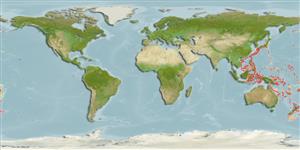Environment: milieu / climate zone / depth range / distribution range
Ecologia
marinhas batidemersal; intervalo de profundidade 310 - 428 m (Ref. 11790). Deep-water
Western Pacific: Japan to the Kei Islands, Arafura Sea (Indonesia).
Tamanho / Peso / Idade
Maturity: Lm ? range ? - ? cm
Max length : 36.0 cm TL macho/indeterminado; (Ref. 9797)
Espinhos dorsais (total) : 0; Raios dorsais moles (total) : 65 - 70; Espinhos anais: 0; Raios anais moles: 45 - 48; Vértebras: 30. Eyes on right side of body and very large, covered with scales on surface. Body uniformly greyish-brown, without distinct markings. Caudal fin rounded (Ref. 559).
Rare species found on mud bottoms (Ref. 9797). Feeds on benthic animals (Ref. 9797).
Life cycle and mating behavior
Maturidade | Reprodução | Desova | Ovos | Fecundidade | Larvas
Masuda, H., K. Amaoka, C. Araga, T. Uyeno and T. Yoshino, 1984. The fishes of the Japanese Archipelago. Vol. 1. Tokai University Press, Tokyo, Japan. 437 p. (text). (Ref. 559)
Categoria na Lista Vermelha da IUCN (Ref. 130435: Version 2024-2)
Ameaça para o homem
Harmless
Utilização humana
Pescarias: sem interesse
Ferramentas
Relatórios especiais
Descarregue XML
Fontes da internet
Estimates based on models
Preferred temperature (Ref.
123201): 7.1 - 14.9, mean 11.1 °C (based on 47 cells).
Phylogenetic diversity index (Ref.
82804): PD
50 = 1.0156 [Uniqueness, from 0.5 = low to 2.0 = high].
Bayesian length-weight: a=0.00851 (0.00359 - 0.02015), b=3.06 (2.85 - 3.27), in cm total length, based on LWR estimates for this (Sub)family-body shape (Ref.
93245).
Nível Trófico (Ref.
69278): 3.5 ±0.37 se; based on food items.
Resiliência (Ref.
120179): Médio, tempo mínimo de duplicação da população 1,4 - 4,4 anos (Preliminary K or Fecundity.).
Fishing Vulnerability (Ref.
59153): Low to moderate vulnerability (26 of 100).
